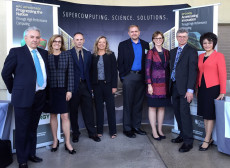Berkeley Lab Joins DOE’s New HPC4Manufacturing Program
CRD Pulp and Paper Industry Project Among First to be Funded
September 16, 2015

At the 2015 ACME meeting: From left, Horst Simon (LBNL), Trish Damkroger (LLNL), John Turner (ORNL), Peg Folta (LLNL), David Skinner (LBNL), Dona Crawford (LLNL), Jeff Roberts (LLNL), Chenn Zhou (Purdue University Calumet)
Lawrence Berkeley National Laboratory (Berkeley Lab) is collaborating with Lawrence Livermore and Oak Ridge national laboratories on a new Department of Energy (DOE) program designed to fund and foster public-private R&D projects that enhance U.S. competitiveness in clean energy manufacturing.
The High Performance Computing for Manufacturing Program (HPC4Mfg), announced this week during the third annual American Energy and Manufacturing Competitiveness Summit (AEMC), couples U.S. manufacturers with the labs' world-class computational research and development expertise to address key challenges in U.S. manufacturing. Through the program, the DOE will initially make up to $5 million available to national laboratories to work with qualified industry partners. The selected projects will apply modeling, simulation and data analysis to industrial products and processes to lower production costs and shorten the time to market for new products.
The HPC4Mfg program is part of the DOE’s Clean Energy Manufacturing Initiative (CEMI), launched three years ago to strengthen U.S. competitiveness in the production of clean energy products and boost U.S. manufacturing competitiveness across the board by increasing energy productivity.
The two-day AEMC summit, sponsored by the Council on Competitiveness and the Office of Energy Efficiency and Renewable Energy, brings together DOE officials, national lab leaders and top U.S. manufacturing CEOs to discuss critical energy and manufacturing challenges and opportunities affecting U.S. prosperity, sustainability and security. Among those attending this year is Peter Nugent, Division Deputy for Scientific Engagement in Berkeley Lab’s Computational Research Division, and David Skinner, who leads the Strategic Partnerships effort at the National Energy Research Scientific Computing Center (NERSC).
“The HPC4mfg collaborations will address key challenges in U.S. manufacturing through the application of modeling, simulation and data analysis to the manufacturing of materials,” Nugent said. “The goals are to improve decision making, optimize design, improve quality, predict performance and failure, quicken testing and shorten the time to adopt new technologies.”
For example, one of the early projects to be funded through the new HPC4mfg initiative involves the pulp and paper industry’s Agenda2020 Technology Alliance, which among other things is looking at ways to reduce the amount of energy consumed in the paper making process and develop a more sustainable approach for manufacturing pulp and paper products. The Alliance will work with CRD’s David Trebotich and other computational researchers from Berkeley and Livermore labs to simulate the dewatering and rewetting operations in paper making and develop a computational modeling framework that incorporates improved physics and conceptual formulations to accurately simulate the flow of moisture to and from the porous pulp medium during the pressing process in paper making.
Skinner, who has spent the past year connecting a number of industry partners with supercomputing resources at NERSC, gave a presentation on some of those projects at this week’s AEMG Summit. So far in 2015, NERSC has added nine new private-sector partners in energy-specific fields ranging from semiconductor manufacturing to geothermal modeling, and several have already begun using their allocations to enhance product and technology development.
“NERSC has been working with industry partners through the DOE’s Small Business Innovation Research (SBIR) grant program for many years,” Skinner said, noting that since 2011 industry researchers have been awarded 40 million hours at NERSC via the SBIR program. “There is a great breadth of industry innovation already underway at NERSC; we have some 130 industry users from 50 companies. The new HPC4Mfg program will allow us to grow the impact of HPC in clean energy technologies. This is an exciting opportunity to get the same HPC capabilities well known to discovery science in the hands of companies designing and deploying clean energy solutions.”
About Berkeley Lab
Founded in 1931 on the belief that the biggest scientific challenges are best addressed by teams, Lawrence Berkeley National Laboratory and its scientists have been recognized with 16 Nobel Prizes. Today, Berkeley Lab researchers develop sustainable energy and environmental solutions, create useful new materials, advance the frontiers of computing, and probe the mysteries of life, matter, and the universe. Scientists from around the world rely on the Lab’s facilities for their own discovery science. Berkeley Lab is a multiprogram national laboratory, managed by the University of California for the U.S. Department of Energy’s Office of Science.
DOE’s Office of Science is the single largest supporter of basic research in the physical sciences in the United States, and is working to address some of the most pressing challenges of our time. For more information, please visit energy.gov/science.









